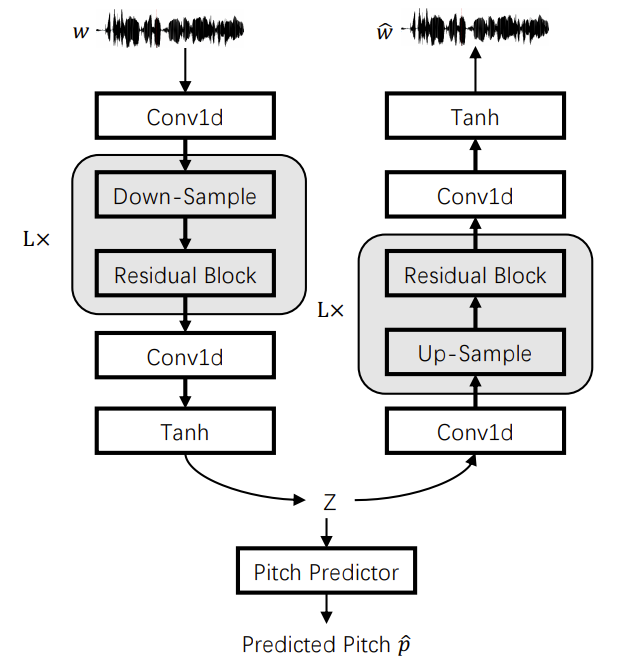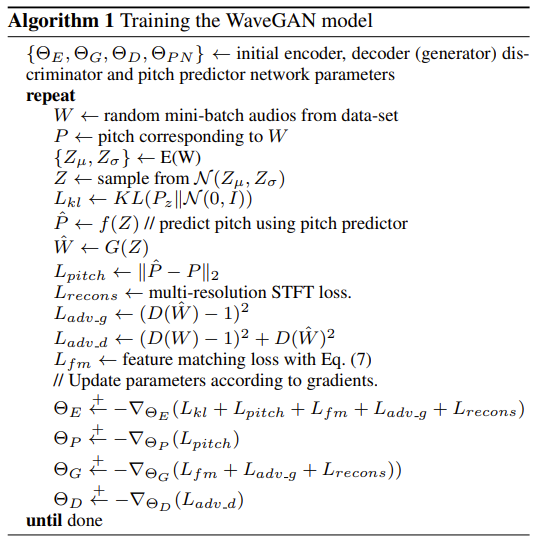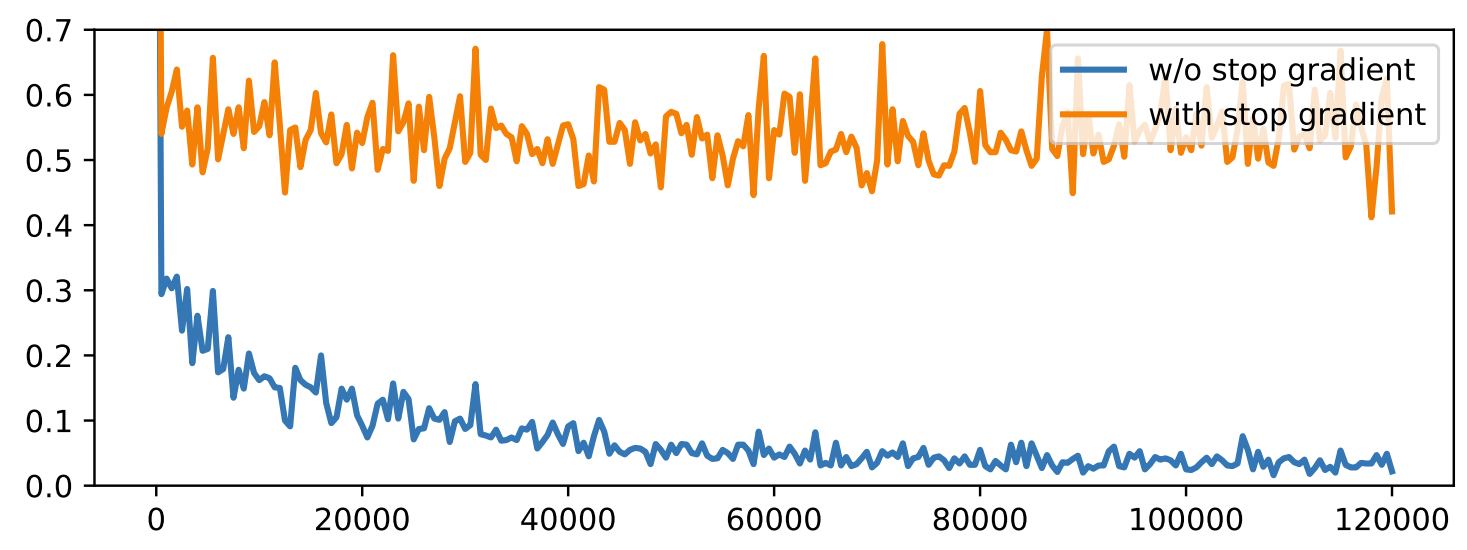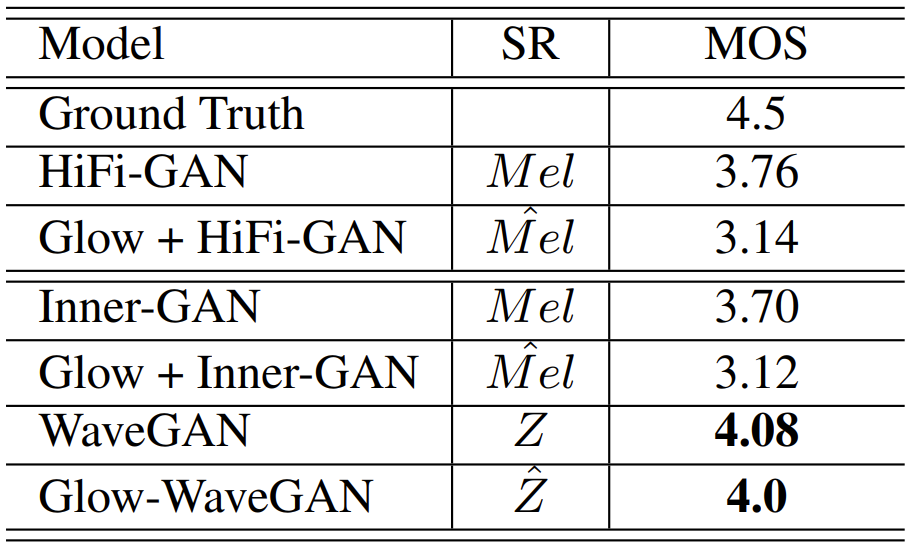티스토리 뷰
Paper/TTS
[Paper 리뷰] Glow-WaveGAN: Learning Speech Representations from GAN-based Variational Auto-Encoder for High Fidelity Flow-based Speech Synthesis
feVeRin 2024. 6. 20. 11:27반응형
Glow-WaveGAN: Learning Speech Representations from GAN-based Variational Auto-Encoder for High Fidelity Flow-based Speech Synthesis
- Text-to-Speech 모델은 주로 mel-spectrogram과 같은 low-resolution intermediate representation에 의존하므로 vocoder와 acoustic model 간의 mismatch가 존재함
- Glow-WaveGAN
- Pre-designed intermediate representation에 의존하지 않고 GAN과 결합된 VAE를 사용하여 speech에서 latent representation을 직접 학습
- 이후 flow-based acoustic model을 활용해 text의 latent representation을 모델링
- 논문 (INTERSPEECH 2021) : Paper Link
1. Introduction
- Text-to-Speech (TTS) pipeline은 크게 acoustic model과 vocoder의 two-stage로 나누어짐
- Acoustic model은 주어진 text나 phoneme sequence에 대해 mel-spectrogram과 같은 intermediate representation을 생성하고, vocoder는 해당 representation으로부터 audio sample을 생성함
- 이때 Tacotron2와 같은 attention-based autoregressive (AR) model은 frame-by-frame으로 mel-spectrogram을 생성하여 우수한 품질을 달성했음
- 한편으로 FastSpeech, FastSpeech2와 같은 non-autoregressive acoustic model은 alignment prediction을 활용해 기존 AR model보다 빠른 합성이 가능함
- 특히 Glow-TTS와 같이 flow-based model을 기반으로 dynamic programming을 통해 alignment를 얻어 TTS 성능을 향상할 수 있음
- Vocoder도 마찬가지로 previous sample에 의존하는 AR model을 고려할 수 있지만, high-temporal resolution을 가지는 audio를 합성하는데 상당히 느린 속도를 보임
- 한편으로 MelGAN, HiFi-GAN과 같은 Generative Adversarial Network (GAN) 기반의 non-AR vocoder는 빠른 속도와 우수한 품질을 지원하고 있음 - BUT, TTS는 여전히 two-stage pipeline으로 인해 acoustic model과 vocoder 간의 mismatch 문제가 존재함
- 이는 text에서 생성된 acoustic feature가 음성에서 직접적으로 추출된 acoustic feature와 다른 distribution에 위치하기 때문
- 특히 model parameter를 추정하기 위해 일반적으로 사용되는 Mean Squared Error (MSE)는 numerical difference만 고려하므로 over-smoothing 문제를 일으킬 수 있음
- 이때 GAN을 활용하여 target speech distribution을 모델링하면 해당 문제를 극복할 수 있음
- Acoustic model은 주어진 text나 phoneme sequence에 대해 mel-spectrogram과 같은 intermediate representation을 생성하고, vocoder는 해당 representation으로부터 audio sample을 생성함
-> 그래서 acoustic model과 vocoder 간의 mismatch를 줄일 수 있는 Glow-WaveGAN을 제안
- Glow-WaveGAN
- Flow-based acoustic model의 target distribution이 vocoder의 distribution과 일치하는지를 확인하는 Variational Auto-Encoder (VAE)를 도입
- 이때 mel-spectrogram과 같은 pre-designed acoustic feature는 사용하지 않음
- 즉, VAE의 encoder는 speech representation을 추출하는 extractor 역할을 수행하고, decoder는 latent representation에서 waveform을 reconstruction 하는 vocoder 역할을 수행
- 추가적으로 reconstructed speech의 품질을 향상하기 위해 output에 GAN을 적용
- Flow-based acoustic model의 target distribution이 vocoder의 distribution과 일치하는지를 확인하는 Variational Auto-Encoder (VAE)를 도입
< Overall of Glow-WaveGAN >
- Flow-based acoustic model을 사용하여 VAE로부터 hidden representation의 distribution을 학습하는 TTS model
- 결과적으로 Glow-WaveGAN은 기존보다 뛰어난 합성 품질을 달성
2. Method
- Glow-WaveGAN은 WaveGAN module과 Glow-TTS module로 구성됨
- WaveGAN module은 waveform reconstruction을 위해 latent speech representation을 학습하고, Glow-TTS module은 WavGAN module에서 학습한 representation에 input text를 mapping 함
- 이때 latent speech representation의 robust distribution을 학습하도록 VAE를 통한 feature extraction, reconstruction을 수행 - 추가적으로 reconstruct 된 음성의 품질을 향상하기 위해 latent representation을 input으로 사용하는 pitch prediction을 도입하고, GAN을 활용해 target speech distribution을 모델링함
- 최종적으로 flow-based acoustic model을 사용하여 VAE encoder에서 추출된 latent representation의 distribution을 학습
- 이를 통해 Glow-WaveGAN은 acoustic model과 waveform reconstruction module이 모두 동일한 distribution을 따르도록 할 수 있음
- WaveGAN module은 waveform reconstruction을 위해 latent speech representation을 학습하고, Glow-TTS module은 WavGAN module에서 학습한 representation에 input text를 mapping 함

- VAE for Learning Representation and Reconstruction
- Two-stage TTS에서 acoustic model과 vocoder 간의 mismatch를 완화하기 위해, 논문은 acoustic model이 vocoder로부터 latent feature의 distribution을 직접적으로 학습하는 것을 목표로 함
- 이를 위해 encoder, decoder를 포함하는 VAE를 사용하여 unsupervised manner로 speech representation을 학습함
- 여기서 encoder는 input $w$를 hidden feature $z$로 encoding 하고 decoder는 $z$에서 $w$를 reconstruct 함:
(Eq. 1) $z=\mathrm{Enc}(w)\sim q(z|w)$
(Eq. 2) $\hat{w}=\mathrm{Dec}(z)\sim p(w|z)$
- $w$ : input waveform
- $q(z|w)$ : hidden feature의 distribution으로, $p(w|z)$ 하에서 waveform $\hat{w}$를 reconstruct하는데 사용됨 - 해당 VAE에는 일반적으로 reconstruction objective $L_{recon}$과 같은 prior regularization term이 포함됨:
(Eq. 3) $L_{vae}=L_{recon}+D_{KL}(q(z|w)||p(z))$
- $D_{KL}$ : Kullback-Leibler divergence, $p(z)$ : prior distribution - 한편으로 reconstruction 성능 향상을 위해 Parallel WaveGAN의 multi-resolution STFT loss를 채택하여 frequency-domain에서 $w$와 $\hat{w}$ 간의 distance를 계산함
- 이를 통해 음성의 time-frequency characteristic을 효과적으로 학습할 수 있음
- 여기서 encoder는 input $w$를 hidden feature $z$로 encoding 하고 decoder는 $z$에서 $w$를 reconstruct 함:
- 구조적으로 VAE는 아래 그림과 같이 구성됨
- Encoder는 음성의 abstact information을 summarize 하기 위한 downsampling convolution layer stack을 사용
- 이때 acoustic model은 sample-level에서 long-term dependency를 학습하기 어렵기 때문에, residual block에서는 long-range context 모델링을 위한 dilated convolution을 채택 - Encoding 이후에는 learned latent distribution $q(z|w)=\mathcal{N}(Z_{\mu}, Z_{\sigma})$의 statistics로 평균과 분산을 얻음
- Decoder는 encoder의 반대로써, sampling 된 $z$를 speech $\hat{w}$로 upsamping 하는 transposed convolution layer stack을 사용
- Encoder는 음성의 abstact information을 summarize 하기 위한 downsampling convolution layer stack을 사용
- 추가적으로 논문은 pitch information을 활용해 latent representation $z$를 향상함
- 이를 위해, 다음의 frame-level pitch reconstuction objective를 사용하여 sampled $z$로부터 pitch information을 예측하는 pitch predictor를 도입:
(Eq. 4) $L_{pitch}=|| f(z)-p||_{2}$
- $p$ : log-scale로 추출된 pitch, $f(\cdot)$ : 2개의 convolution layer, linear output layer로 구성된 predictor
- Pitch extraction의 frame-shift는 total down-sampling factor에 따라 달라짐
- 이를 위해 encoder, decoder를 포함하는 VAE를 사용하여 unsupervised manner로 speech representation을 학습함

- GAN for High-Fidelity Speech Reconstruction
- 앞선 VAE로 reconstruct 된 음성에는 audio artifact가 존재할 수 있으므로, 논문은 GAN을 도입해 품질을 더욱 향상함
- 이를 위해, pitch predictor를 포함한 VAE를 GAN의 generator로 처리함
- 즉, generator는 waveform을 hidden $z$로 encoding 한 다음, $q(z|w)$에서 sampling 된 $z$로 음성을 생성함
- Discriminator는 real sample $w$와 생성된 sample $\hat{w}$를 classify 하도록 최적화되고, 합성 시에는 generator의 decoder 부분만 waveform reconstruction에 사용됨 - Adverasrial training을 위해, 논문은 least-squares GAN objective를 활용하여 다음과 같이 generator, discriminator loss를 정의함:
(Eq. 5) $L_{adv\text{_}g}=(D(G(w))-1)^{2}$
(Eq. 6) $L_{adv\text{_}d}(D(w)-1)^{2}+D(G(w))^{2}$
- $G$ : generator (VAE의 encoding, decoding part에 해당)
- $D$ : Universal MelGAN의 multi-resolution spectrogram discriminator - 추가적으로 generator를 training 하기 위해 feature matching loss를 추가함:
(Eq. 7) $L_{fm}=\sum_{s}\sum_{i}\frac{1}{N_{i}}||D_{s}^{i}(w)-D_{s}^{i}(G(w))||_{1}$
- Feature matching loss는 각 discriminator의 intermediate layer에서 추출된 feature map 간의 $L1$ distance를 최소화하는 것을 목표로 함
- $D_{s}^{i}(\cdot)$ : $s$-th discriminator의 $i$-th output, $N_{i}$ : 각 layer의 unit 수 - 최종적으로 앞선 loss들을 결합한 full objective는:
(Eq. 8) $L=\lambda_{1}L_{kl}+\lambda_{2}L_{pitch}+\lambda_{3}L_{recon}+\lambda_{4}L_{adv\text{_}g}+\lambda_{5}L_{fm}$
- $L_{kl}$ : (Eq. 3)의 Kullback-Leiblelr divergence
- $\lambda_{1}=10, \lambda_{2}=1, \lambda_{3}=1, \lambda_{4}=1,\lambda_{5}=20$으로 설정 - 한편으로 discriminator는 adversarial loss $L_{adv\text{_}d}$로 최적화되고, 전체 training procedure는 아래 [Algorithm 1]을 따름
- 이때 decoder VAE와 discriminator를 결합한 architecture는 input representation $Z$를 mel-spectrogram으로 대체하여 GAN-based vocoder로써 사용할 수 있음

- Flow-based Acoustic Model
- VAE와 GAN을 포함하는 WaveGAN을 통해 latent representation을 추출하는 extractor와 waveform을 합성하는 speech reconstructor를 얻을 수 있음
- 이에 따라 acoustic model은 latent represent $z$의 distribution을 모델링하도록 설계되고, 논문은 Glow-TTS를 기반으로 invertible transformation을 적용해 $z$의 likelihood를 최대화함
- 먼저 training data의 statistics $Z_{\mu}, Z_{\sigma}$를 추출하자
- 이때 Glow-TTS는 flow-based decoder $f_{dec}:c\rightarrow z$를 통해 conditional prior distribution $P_{C}(c|t)$를 transforming 하여 speech representation $P_{Z}(z|t)$의 conditional distribution을 모델링함
- $t$ : text sequence - Prior distribution $P_{C}(c|t)$의 경우, text $t=t_{1:M}$의 각 token에서 statistics $C_{\mu}=C_{\mu_{1:M}}, C_{\sigma}=C_{\sigma_{1:M}}$을 계산
- $M$ : sequence length - 그러면 다음과 같이 variable change를 사용하여 $Z$의 log-likelihood를 얻을 수 있음:
(Eq. 9) $\log P_{Z}(z|t)=\log P_{C}(c|t)+\log \left|\det\frac{\partial f_{dec}^{-1}(z)}{\partial z} \right|$
- 여기서 prior distribution $P_{C}$는 isotropic multivariate Gaussian distribution을 따름
- 이때 Glow-TTS는 flow-based decoder $f_{dec}:c\rightarrow z$를 통해 conditional prior distribution $P_{C}(c|t)$를 transforming 하여 speech representation $P_{Z}(z|t)$의 conditional distribution을 모델링함
- Target variable $z$와 input variable $t$의 sequence는 완전히 다르므로, $\log P_{C}(c|t)$를 계산하려면 두 sequence를 align 해야 함
- 이때 Glow-TTS와 마찬가지로 Monotonic Alignment Search (MAS)를 사용하여 $z$에서 각 $c$로 mapping 함
- 여기서 $c_{j}\sim \mathcal{N}(c_{j};C_{\mu_{i}},C_{\sigma_{i}})$이면 $A(j)=i$ - 결과적으로 prior distribution의 log-likelihood는:
(Eq. 10) $\log P_{C}(c|t;\Theta,A)=\sum_{j=1}^{N}\log \mathcal{N}(c_{j};C_{\mu_{A(j)}}, C_{\sigma_{A(j)}})$
- $N$ : WaveGAN의 speech representation $Z$의 length
- Parameter set $\Theta$와 alignment $A$의 trainable variable은 iteratively optimize 됨
- 이때 Glow-TTS와 마찬가지로 Monotonic Alignment Search (MAS)를 사용하여 $z$에서 각 $c$로 mapping 함
- 해당 Glow-TTS를 사용하여 WaveGAN의 explicit distribution $\mathcal{N}(Z_{\mu},Z_{\sigma})$를 prior conditional distribution $P(c|t)$로 변환함
- 각 training step에서는 pre-sampled constant target을 사용하는 대신 $\mathcal{N}(Z_{\mu},Z_{\sigma})$에서 target $z$를 sampling 함 - 추론 시 flow-based acoustic model은 text에서 distribution $\mathcal{N}(Z_{\mu}, Z_{\sigma})$를 따르는 $\hat{z}$를 생성할 수 있음
- 이는 WaveGAN의 decoder에 추가로 전달되어 high-fidelity의 reconstuction을 지원함
- 이에 따라 acoustic model은 latent represent $z$의 distribution을 모델링하도록 설계되고, 논문은 Glow-TTS를 기반으로 invertible transformation을 적용해 $z$의 likelihood를 최대화함
3. Experiments
- Settings
- Dataset : LJSpeech, VCTK
- Comparisons : Glow + HiFi-GAN
- Results
- MOS 측면에서 Glow-WaveGAN은 가장 우수한 성능을 달성함

- Pitch predictor의 효과를 확인하기 위해, input에 stop-gradient operator를 추가하여 Glow-WaveGAN을 training 함
- 이때 stop-gradient가 적용된 경우 모델이 전혀 수렴하지 않는 것으로 나타남
- 즉, pitch predictor를 사용하지 않으면 speech representation $Z$에 exact pitch information이 반영될 수 없음

- 추가적으로 VCTK의 unseen speaker에 대한 합성 품질을 비교했을 때도, Glow-WaveGAN의 성능이 가장 뛰어남

반응형
'Paper > TTS' 카테고리의 다른 글
댓글

